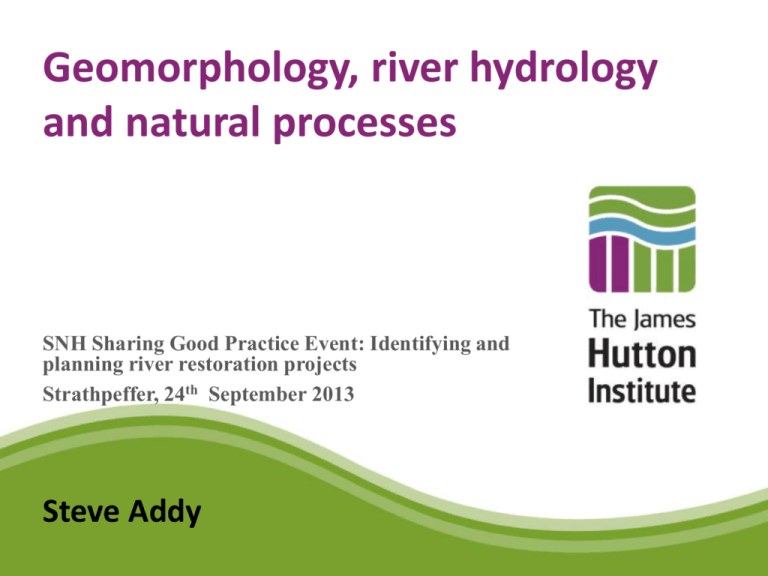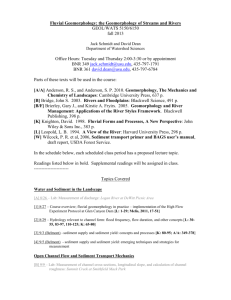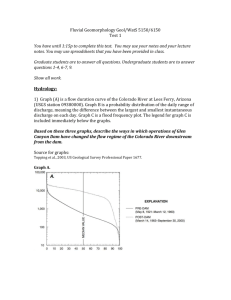Geomorphology, river hydrology and natural processes
advertisement

Geomorphology, river hydrology and natural processes SNH Sharing Good Practice Event: Identifying and planning river restoration projects Strathpeffer, 24th September 2013 Steve Addy Outline Controls on channel morphology Fluvial processes Channel morphology variability River types Links to river ecology Some definitions Fluvial geomorphology Fluvial: rivers and streams Geomorphology: the study of landforms and the processes that form them Hydromorphology WFD leglislative term that encompasses fluvial geomorphology and hydrology (i.e. the physical factors that govern river ecosystems) Alluvial Sediment moved and deposited by rivers Why is fluvial geomorphology important? • Fluvial forms and processes are recognised as a key component of river systems in EU WFD and national legislation • River landforms and flows constitute the basic ‘physical template’ that influences riverine biota • Fluvial geomorphology input is needed for sustainable river management and restoration • For mitigating flood risk and geomorphic hazards Channel morphology Consists of 5 variables that are inter-dependent i.e. change of one variable leads to change in others in response to alteration of the fundamental drivers Water and sediment inputs Valley width Width Roughness (sediment and bedforms) Depth Channel pattern (Church, 2006) Scales of channel adjustment (Buffington, 2012) Boundary conditions: inherited topography, geology and sediment sources • Topography reflects millions of years of landscape development • Scottish landscapes have been conditioned by glaciation and rivers are still adjusting to this legacy. Boundary conditions: bed and bank material Sparse vegetation, noncohesive alluvial banks Dense vegetation, cohesive Bedrock banks alluvial banks Alluvial bed Alluvial bed Bedrock bed Increasing channel boundary resistance Boundary conditions: large dead wood • Wood is an important component of natural river ecosystems • Can create significant flow resistance (hydraulic roughness) • Influence on sediment transport and river bed habitats (Soulsby, 2006) Drivers: sediment supply Tributaries Hillslopes Alluvial banks Glacigenic landforms Drivers: hydrology • Determines channel size and the movement of material • How catchments respond to precipitation and snowmelt and in turn generate river flow depends on: - Climate - Topography - Land use - Vegetation - Soil - Geology - Superficial drift cover (Source: Metoffice, 2012, Open Government License) River flows over time Understanding how flows change (magnitude and frequency) over time is important for understanding channel changes, predicting and managing flood risk Sources of information: Flow gauging network (~100 years) Historical record (centuries) Geomorphic record (1000s of years) Old Bridge, Perth River Dee at Woodend Source: http://www.environment-agency.gov.uk/cy/hiflows/ River flow in open channels Bankfull Wetted perimeter (WP) Area (A) Hydraulic radius (R) a measure of channel shape Depth is given by the formula: (stage) R = A/WP Discharge (Q, m/s3) or flow, is defined as the rate at which a volume of water travels through a cross-section per unit of time. Given by the formula: Q=AxV Velocity (V, m/s) is given by the Manning equation: V = (1/n) x R0.66 x S0.5 Where S slope (m/m) and ‘n’ Manning’s roughness Energy • Stream power and boundary shear stress are often calculated to give a measure of the energy available to do geomorphic work in a river. • du Boys (1879) boundary shear stress equation (τ, N/m2): gdS where ρ is the water density (1000 kg/m3), g is gravitational acceleration (9.81 m/s 2), d (m) is the average channel depth and S (m/m) is the channel slope. Variability of shear stress Determined by differences of flow, channel geometry (depth) and slope Higher shear stress Lower shear stress Same discharge and channel geometry Same channel slope and geometry Same discharge and channel slope Fluvial processes: sediment transport Dissolved load Turbulence Rolling Sliding Bed surface Fluvial processes: sediment transport • Washload or suspended load is the movement of fine (generally < 2 mm) material in suspension • Bedload movement is the movement of coarse sediment along the bed; most important in terms of shaping channel morphology • Transport capacity – the volume of sediment that can be transported • Competence – the maximum size of sediment that can be transported Predicting sediment entrainment When shear stress applied by a flow exceeds the critical shear stress (i.e. the resistive force) required to mobilise a particle, entrainment occurs Critical shear stress (τc, N/m2) can be calculated by using the Shields (1936) equation: τ = ρsτ*Dig where ρs is the specific density of sediment set to 2650 kg/m3, τ* is the Shields dimensionless critical shear stress value, Di is the particle size of interest and g is gravitational acceleration (9.81 m/s 2) Further controls on sediment entrainment Armour layer Flow direction Sub-surface layer Armouring Imbrication Bedform and grain roughness Packing, protrusion and hiding effects Fluvial processes: sediment deposition • Occurs when sediment in transport falls below a threshold velocity • Controlled by channel geometry, roughness and changes of discharge Washload deposition Bedload deposition Dominant discharge • Exceptional flood events that exceed bankfull can significantly alter channel morphology through sediment transport and have a long lasting morphological impact • However smaller flows, dominant discharge (~bankfull) flows that occur every 1-2 years (~median annual flood) may have a greater control on average channel size, sediment characteristics and pattern. Low flow ~Bankfull flow Fluvial processes: bank erosion • Common mode of adjustment in coarse bedded rivers. • Rate controlled by material properties, vegetation, weather and degree of scour by flowing water • Allows accommodation of prevailing flow regime and creates habitat Fluvial processes: channel migration (Hooke, 1977) (Winterbottom and Gilvear, 2000) Channel variability in space Magnitude Stored sediment Bed material size Channel gradient Stream flow Stream power Drainage area, distance downstream (adapted from Church, 2002) Local ‘step’ changes Alluvial reach Bedrock reach Channel morphology equilibrium and variability over time (from Buffington, 2012) Channel morphology equilibrium and variability over time • Channels in perfect equilibrium: sediment input = sediment output • Seldom occurs in reality, channels tend to be in a state of dynamic- or quasi-equilibrium • Channel equilibrium can be perturbed but will evolve towards a new state of equilibrium Quasi Dynamic Response to a major disturbance (Knighton, 1998) Channel degradation Incised channel Unaffected section A useful link: ‘River Geomorphology Videos’ http://serc.carleton.edu/NAGTWorkshops/geomoph/emriver/i ndex.html Sudden channel change Jan 2007 March 2009 30 m Channel response to impoundment: upper River Moriston (RCAHMS, 2010) 10 years before dam completion (RCAHMS, 2010) 15 years after dam construction Get Mapping, 2010) 48 years after dam construction Channel classification (Montgomery and Buffington, 1998) Bedrock channels High gradient for a given drainage area and high transport capacity relative to sediment supply Limited sediment storage and highly stable Often form ‘knick-points’ in river profiles and base levels Boulder-bed channels High gradient, confined channels dominated by boulder and cobble substrate High transport capacity relative to sediment supply Exhibit cascade or step-pool morphologies that are stabilised by large ‘key-stones’ Plane-bed and plane-riffle channels Medium to low channel gradient characterised by a relatively featureless bed topography Transport capacity to sediment supply ratios are in balance Low sinuosity and variable floodplain extent Meandering channels Low channel gradient characterised by an undulating bed topography Tend to have pool-riffle sequences and extensive floodplain Sediment deposition over point bars balanced by erosion on outside of meanders (SNH/Aerographica) Wandering channels Low gradient channels with locally braided planform and extensive sediment storage Characterised by a high sediment supply to transport capacity ratio Associated with rapid channel migration and avulsion (channel switching) Braided channels Low gradient channels with mutliple channels and a wide active channel width Characterised by a high sediment supply to transport capacity ratio due to coarse sediment inputs from upstream and weak banks Associated with the highest rates of channel migration (SNH) (Scottish Rivers Handbook, 2013) Fluvial geomorphology and lotic habitats Catchment and river processes Channel geomorphology Physical habitat Biota Water quality, temperature and species pool (Gilvear, 2011) (Scottish Rivers Handbook, 2013) Connectivity and complexity in river systems (from Naiman et al., 2006) “The biophysical complexity (heterogeneity) of rivers underpins their long-term vitality” Naiman, 2006 River Nethy (Gilvear, 2011) (Gilvear, 2011) Ballinluig Island (SSSI), River Tummel 1946 1989 1994 1999 150 plant species: two national rarities Purple Iris and Jacobs Ladder (both introduced) and the native nationally rare plants Maiden Pink and Shady Horsetail, plus 31 locally rare higher plants. (Gilvear and Wilby, 2006) Distribution of channel types and spawning habitat Riffle units in low gradient alluvial reaches preferred. Freshwater pearl mussel habitat Physical habitat quality dictated by the ability of mussels to burrow into bed sediments and the stability of the substrate over time Survival also depends on a healthy salmon population and the habitat to support it Summary • For a given river section, its morphology is characterised by five variables: cross-sectional shape, sediment size, slope, bedforms and planform • Rivers naturally adjust these variables to the imposed natural drivers and ultimately evolve towards the most stable and efficient condition for transporting water and sediment • Artificial alteration of controlling factors may cause a departure from its natural adjustment or equilibrium and in turn have undesired consequences • Different river types and features will play a role in maintaining differing species and lifestyles. River complexity, heterogeneity and a shifting habitat mosaic is important







